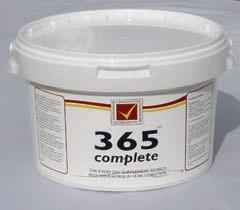
12 minute read
Score sheets analysed
PART 3
BEYOND THE COMMENTS
OUR FOCUS TURNS TO THE HORSE’S BACK WHICH LINKS THE FOREHAND AND HINDQUARTERS WHICH HAVE BEEN PREVIOUSLY HIGHLIGHTED. JANE KIDD EXPLAINS THE IMPORTANCE OF HAVING A HORSE WORKING THROUGH THE BACK AND CLARIFIES THE MEANING BEHIND SOME COMMON COMMENTS FROM JUDGES.
The back is the bridge between the two areas we’ve looked at in the previous articles in this series – the forehand and the hindquarters. It’s often overlooked as it takes skill, experience and knowledge for judges, riders and trainers to assess how well it’s working. he eff ects o a bac that is working well are profound. The increasing importance given to it distinguishes a ‘happy athlete’ (FEI’s objective) from a merely ‘obedient horse’ and from the dressage horses of the past to that of modern times.
One of the reasons why the way the back works has become of greater importance is the increasing opportunity to make it supple and swinging. The conformation of most of the horses in the past had backs
ABOVE: THE BEST TEST OF WHETHER A HORSE IS USING ITS BACK IS THAT WHEN THE RIDER EASES THE CONTACT IN THE REINS THE HORSE STRETCHES FORWARD AND DOWN. THIS YOUNG HORSE HAS CLEARLY BEEN USING ITS BACK MUSCLES. RIGHT: ALLOWING THE HORSE TO WORK IN A MORE HORIZONTAL OUTLINE HELPS TO GET THE BACK TO SWING. THIS IS THE WAY MOST HORSES ARE RIDDEN IN THE EARLY STAGES OF THEIR TRAINING AND AS THE WORK ADVANCES, AT THE START OF THE WARM UP, AS WELL AS BETWEEN EXERCISES AS A REWARD, TO CHECK IF THE BACK IS MOBILE OR TO ENABLE THE BACK TO BECOME MORE SUPPLE AGAIN. that were di cult to mobilise. Selective breeding of today’s dressage horses has corrected this handicap. Another reason is that it has taken time to build up and spread the knowledge and ability needed to train a horse to work through its back. TRAINING THE BACK Fundamental to recognising and achieving a supple back is that the rider/trainer knows how it works. It’s a shock for a young horse to carry a heavy weight on its back and it tends to respond by hollowing and tightening its muscles. This reaction obstructs su leness and ma es it di cult for the momentum generated in the hindquarters to pass through to the bit. Also, the muscles aff ected are the ones which are designed to facilitate movement and help the paces


LEFT: THIS IS A GOOD EXAMPLE OF THE RESULTS OF A SUPPLE BACK, A CLEARLY FORWARD GOING EXTENSION WITH A CLEAR MOMENT OF SUSPENSION.

ABOVE LEFT: THIS IS A GOOD EXAMPLE OF THE RESULTS OF A SUPPLE BACK, FORWARD GOING EXTENSION WITH A CLEAR MOMENT OF SUSPENSION. ABOVE MIDDLE: FREE MOVEMENT OF THE BACK MUSCLES HELPS TO KEEP THE WALK REGULAR AND THE EASIEST CHECK THAT THE RHYTHM IS CORRECT IS THAT THE LATERAL PAIRS FORM A ‘V’ SHAPE AT A STAGE IN THE SEQUENCE. ABOVE RIGHT: FEW HORSES CAN PRODUCE AS CLEAR A MOMENT OF SUSPENSION TO THE CANTER AS THIS ONE, BUT ALL THAT HAVE A SUPPLE BACK CAN AIM FOR AN UPHILL TENDENCY WITH A ‘JUMP’ TO EACH CANTER STRIDE.
become expressive. It takes time, some say up to two years, to build up the strength in the postural muscles and of the ligaments to carry the weight of the rider without adversely aff ecting the freedom of the movement muscles.
The essence of the training is to ride forward to the bit with the horse in a position (usually horizontal or stretching forward and down) that it can use the ligaments along its top line and lift rather than hollow the spine. This is the training tool that more and more riders are using to give their horse a supple back, although it varies from horse to horse, rider to rider and trainer to trainer as to how much time is given to this.
It’s a method that can be used at every stage in the training – in the riding in, the letting down at the end of a session and whenever the back tightens through such things as anxiety, resistance, physical weakness or problems. IMPORTANCE OF A SUPPLE BACK A supple back is not just of value in itself as a mark earner in tests but a way towards developing a ha y athlete. A stiff bac adversely in uences the scales o training , particularly rhythm.
In the walk a tight back is a, if not the, major cause of irregular walks and the tendency towards, or resulting in the serious fault a pace (the two-time walk).
In trot it restricts the freedom, a moment of suspension and ultimately cadence.
In the canter, like the trot, it aff ects the moment o sus ension resulting in at movement, the loss of that vital jump and a tendency towards four time.
For dressage s ultimate aim, the ability to lower the hindquarters and lighten the orehand, a stiff bac ma es it more di cult or the horse to step under its weight and achieve this.
JUDGE’S COMMENT: SWINGING BACK This is the most obscure of the judges’ comments. It’s used in the trot, the pace in which there is diagonal movement with the off hind and near ore swinging orward together ollowed by a similar movement o the near hind and off ore. In a high uality trot, the fi rst air are still off the ground as the second air ta e off . For a short time there are no eet on the ground, the moment of suspension. To achieve this, the muscles in the back contract and relax diagonally so there is a swing from one set of diagonal muscles to the other. his can only be eff ective i the muscles are supple and free, a swinging back. When this is happening the tail will swing. I the bac is fi ed, then the horse is a leg mover’ and the back plays little or no part in the “ SWINGING movement and correct suspension is impossible. Possible corrections: Remedies vary
BACK” according to the causes. Anxiety, tension, coming above the bit, a backward tension in the movement needed to develop reins may be causes that can be corrected relatively easily through reassurance, amiliarisation with diff erent environments, and wor on the scales of training, particularly contact.
However, some of the corrections are long term as there is a need to go back to the basic training as discussed above or for the rider to work on their seat and hands, discussed below.
It’s important to accept that for some horses it may be very di cult i not im ossible to be su le and move through their bac , this includes older horses and backs not conformed to swing.
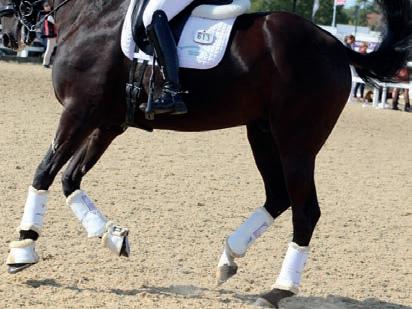

RIGHT: A SUPPLE BACK HELPS A HORSE LIKE THIS TO PRODUCE A CLEAR THREE-TIME CANTER WITH THE HINDQUARTERS WELL ENGAGED AND OBVIOUSLY UPHILL.


JUDGE’S COMMENT: BACK IS NOT SUPPLE/TIGHT IN BACK These comments are as they appear, that the muscles along the top do not move freely, contracting and relaxing as required in all three paces. In the trot, the supple back is a swinging back. In the walk and canter, the muscles need to be supple to assist in maintaining the four- and three-time sequence respectively. The judges are looking for a back that is supple in all three paces and that is what the riders should aim to develop.
Possible corrections: as for swinging back. JUDGE’S COMMENT: HOLLOW BACK/BACK LACKS ROUNDNESS When the back dips away from the rider’s weight, the muscles cannot move freely. To allow the muscles freedom of movement, the ligaments that are attached to the spinal processes of the back’s vertebrae lift them through good training over time (the stretching forward to the bit, see above). This takes some of the burden of the weight, gives space for the muscles to work and creates an impression of the back rounding rather than hollowing.
Possible corrections: as before.
LEFT: A REASON A HORSE DOES NOT STEP UNDER THE WEIGHT MORE CAN BE A TIGHT BACK. BELOW: A HORSE THAT IS ABLE TO TRACK UP (HIND STEPS INTO OR IN FRONT OF THE FOREFOOT’S IMPRINT ON THE SAME SIDE) USUALLY NEEDS A BACK THAT IS SUPPLE.
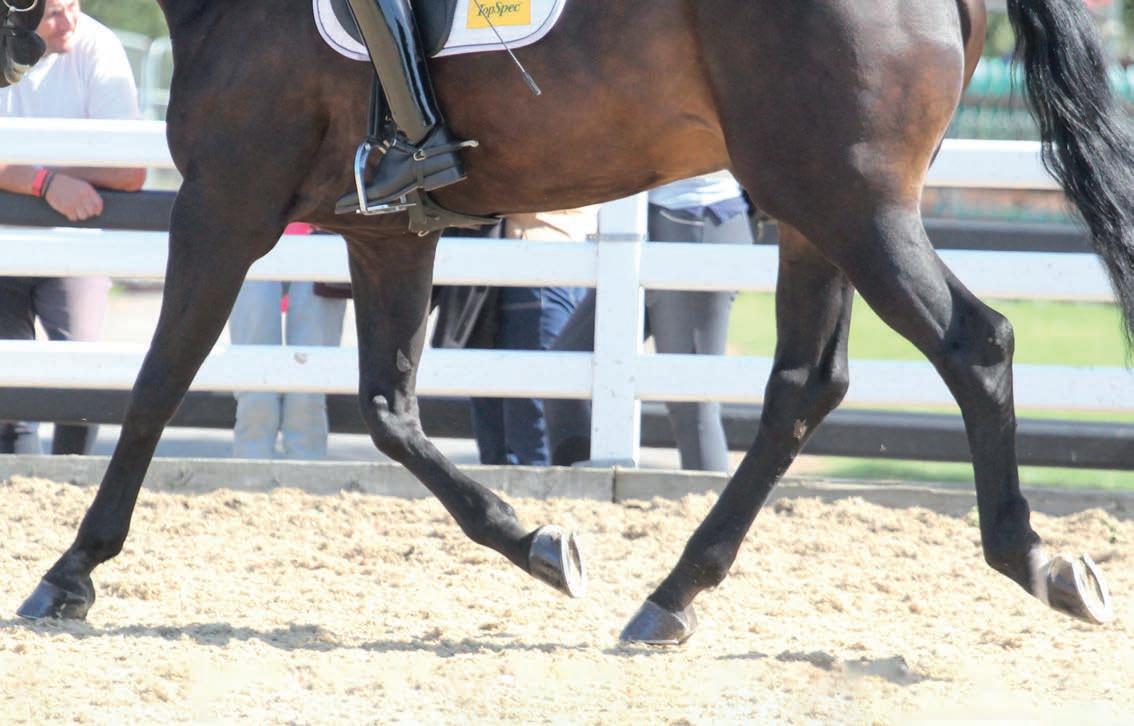
JUDGE’S COMMENT: CONNECTED The back can do much more than join the hindquarters to the forehand. It can connect the movement, the momentum and the energy produced in the hindquarters to the forehand. The power is generated when a hind leg swings forward to compress and open its joint. If the horse is connected, this can be transferred over the back to reach the bit and the rider’s hands. Then the rider can control and direct this power, the horse can work as a whole unit and not in sections such as a leg mover.
Possible corrections: As before, it’s a matter of making the back supple and the rider developing the skills to enable the momentum to pass from behind, along the top line into the bit.
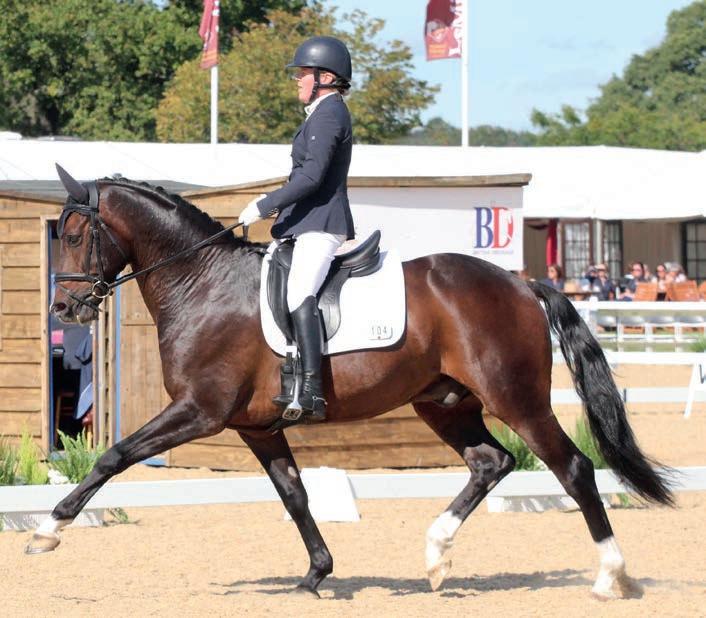

RIGHT: WITH THE INCREASING IMPORTANCE OF THE HORSE MOVING THROUGH THE BACK, RISING TROT IS BEING USED MORE WIDELY. THIS IS BEING AIDED BY IT BEING ALLOWED IN HIGHER AND HIGHER LEVEL TESTS.

JUDGE’S COMMENT: NOT CHANGING DIAGONALS “NOT CHANGING At the lower levels, tests can be ridden in DIAGONALS” rising trot and this is a good way of helping the horse’s back to swing in trot. As the rider sits on one diagonal and rises on the other, for the horse to keep the diagonals working equally they should change the diagonal to which they sit. This is done by sitting to two beats, not just one and it is usual to rise on one diagonal when working on one rein, and the other diagonal on the other rein.
JUDGE’S COMMENT: RIDER RESTRICTING BACK MOVEMENT Judges are reticent to make enough to lighten the load on the this comment as they know horse’s back, knowledgeable and how di cult it is or the experienced enough to direct inexperienced, the part-timers the movement in the best way and those who are naturally stiff is a great deal to ask. Making to develop the skills to ride and the goal clear by reading books, train a horse to have a supple listening to the corrections and back. Nevertheless, it’s all too aims o a trainer, wor ing off common. The important point the horse with pilates, qi gong, is that all riders can have it as a yoga etc. all help. Absorption is goal, and work towards it even another effective tool, watching if never reaching it. Riders do successful riders with great not have to be ‘perfect’ as small concentration and, if fortunate improvements can have a big to ride with these competitors, effect on the way o going. studying online sessions and Possible corrections: For DVDs with them and giving a rider to be supple enough to more time to focused ‘looking’ at follow the movement, balanced the good riders at events.
LEFT: THE RIDER APPEARS TO HAVE A BALANCED AND SECURE SEAT. THIS MAKES IT EASIER TO FOLLOW THE MOVEMENT IN THE HORSE OR PONY’S BACK AND IS A MAJOR AID TOWARDS THE HORSE WORKING WITH A SUPPLE BACK.
PREMIUM SUPPLEMENTS LOW PRICES!!
PREMIER FLEX HA (joint supp) 1kg only £42.99 PREMIER FLEX PLUS (with devils claw) £48.99
365 COMPLETE (feed balancer) only £24.95 BUTE SUBSTITUTE 1 Litre only £17.95 MUD WARRIOR 1kg 45 day supply £29.95 MUD WARRIOR CREAM 200g
£5.50
CALMA (unique triple action formulation) 1kg £31.50 FARRIERS FAVOURITE (hooves) 2kg £23.99 PURE MSM 500g (cheap!) £12.95 VIRGIN LINSEED OIL 5 litres
£24.95
PREMIERflex HA
ONLY £42.99!!
(4 month supply)
Why Choose Premier Flex HA?
Not all equine joint supplements are the same, in fact they differ enormously in the levels of the active ingredients contained in them. A top quality joint supplement should contain not only a good level of Glucosamine which is a relatively cheap ingredient but also high levels of Chondroitin, HA and MSM. Premier Flex HA is possibly the highest spec equine joint supplement today!
Even the horses are talking about us!

Order direct from the
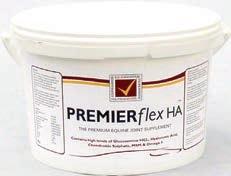
NAF 5 STAR SUPERFLEX CORTAFLEX VETVITS EQUI FLEX PREMIERflex HA 58p 48p 36p 35p
365 COMPLETE
ONLY £24.95!!
* based on medium sized tub
(50 days supply)
365 Complete is a superb high spec balancer that goes far beyond normal vitamin and mineral products. 365 Complete includes every vitamin and mineral a horse needs and these minerals unlike many products are provided in chelated form which makes them far more absorbable. 365 Complete also includes pre and pro-biotics (gut health), MSM (joints, skin, breathing etc) and biotin (feet). 365 Complete helps keep horses in peak condition, the spec on 365 Complete is unsurpassed and yet it is still much cheaper than well known balancers.
“I am not one usually to write about products, but as a HUGE sceptic before I tried it, I just had to drop you a line about 365 Complete. I cannot believe the difference in my 5yo in the short time I have been feeding him 365 Complete, his coat is gleaming, he's so relaxed and content and he is bristling with good health!!” Annie Holbeche
manufacturer and save £££’s!
